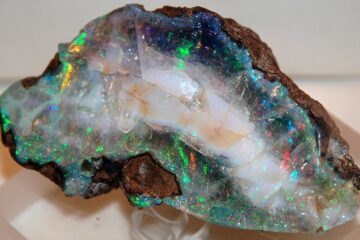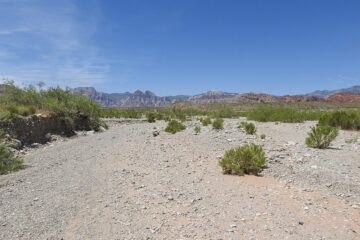Small Scale Hard Rock Gold Mining and Ore Processing
There isn’t much information out there that covers hard rock gold ore processing for the prospector or small scale miner. It’s become something of a lost art. Years ago, there were 100’s even 1000’s of small hard rock gold mines across the southwestern US. Some were marginal operations, some quite profitable.
With World War II came war limitation order L-208, which shut down all gold mines in the US, so that all mining went to the production of steel and strategic metals for the war effort. Small scale gold mining never really came back after the war. There was sporadic small mining in the 1950’s, and today there is the occasional small mining operation.
Most gold production today comes from massive open pit mines that process millions of tons of low grade ores in return for tons of gold. Did you know that if Nevada were a country, It would rank as the fourth largest gold producer in the world.
This post will try to answer some of the questions you may have on how you can process gold ore. Aimed at the prospector and small miner. There are more steps involved in hard rock gold ore processing than in other types of gold mining, but there is more profit involved too, potentially, a lot more.
Using the methods and equipment outlined here, you should be able to process gold ore and extract the gold in an efficient, environmentally friendly manner. You can set up a small gold mill to use at home, or trailer mount the various components to take with you. These are the basic steps involved, and I will go over each in detail.
First, before investing in a small hard rock mill, you should become knowledgeable about how to recognize and sample gold ores. I have a couple of posts that go hand in hand with this one, and should help you to identify and sample good high grade gold ores. Proper sample processing will give you a good idea of much gold you can expect to recover from your ore.
Should you have your ore assayed
Probably not. I personally never send my samples out to be assayed. There are reputable assayer’s out there, there are also assayer’s out there that should not be in business.
If you want to confuse yourself, send out three properly divided portions of the same sample to three different assayers. I can almost guarantee that you will get back three completely different results. Been there, done that.
Also, assays are not cheap, and you will need many of them to follow the highest gold content in any given ore vein.
The real problem with assays is that they will, if done properly, reveal the total gold content in an ore, including gold that may be nearly impossible for you to recover. I don’t really care how much gold is in an ore, what I do care about is how much I can recover, simply, efficiently, without having to use methods and equipment that are well beyond my expertise, and my budget. Process your own ore samples, using the same basic steps you would use on a larger scale.
Profitable Ores
There are two main factors that will affect your profit. They are the size of your mill and the grade and quantity of your ore. If you run across a large, low grade ore stockpile outside of an old mine, you might profitably process it.
The problem with that is you are going to need a gold mill that can process at least a ton or more an hour. That becomes very expensive.
A one ton an hour hard rock mill will run you anywhere from $50,000 to $100,000 or more. If you have a smaller mill that will process say 100 to 200 pounds an hour, then in turn, you wont be able to process enough lower grade ore, fast enough, to make a decent profit.
My solution to that is, go with a mill that can process small amounts of ore, 100 or 200 pounds an hour, maybe less. A lab mill basically. You should be able to put a mill of that size together for less than $10,000. Possibly quite a bit less if you are resourceful.
The other part of the solution is to put boots on the ground and find some good high grade. That’s not as hard as it sounds, especially if you prospect remote areas, in and around old gold districts that were known for small high grade mines. Research old mining bureau reports, old geologic reports, even old newspapers using a great free online tool called Chronicling America .
See How to find gold – Mining Research for more on that.
Always carefully sample in and around any small prospects you may find. I’ve processed ore as high as 40 ounces per ton and as low as 4. Nearly all of these ores have come from old, remote gold prospect pits and pockets.
The 40 oz. per ton ore was hand picked from outside a very remote, small prospect. It took two of use about two weeks to pack out a bit less than a ton and a half of this high grade. We made over $18,000 on that ore, with gold prices at about $300 an ounce. At todays prices that would be more than $100,000.
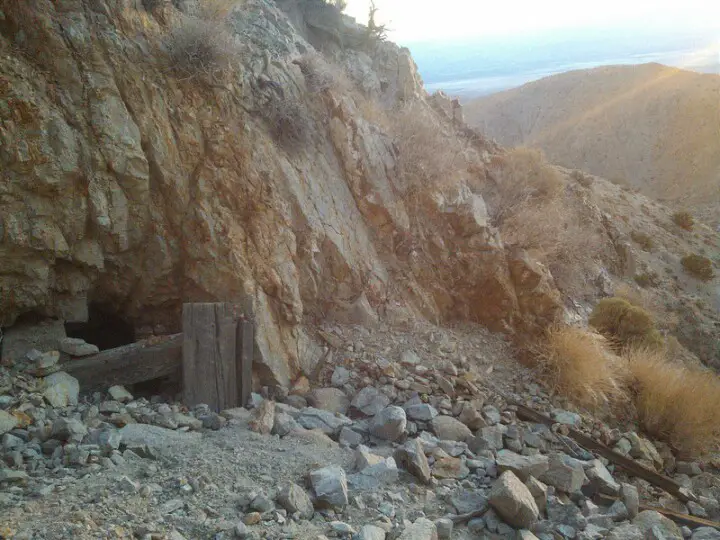
Pocket mine where we found 40 ounce per ton ore
Why don’t I go back and get more ore?
The easy pickings are gone. There is more rich ore inside that pocket mine, of that I have no doubt. This was a pocket of ore where many small quartz veins and stringers came together. The ore was removed in the shape of a horizontal underground “room” or lens of about 1,500 square feet. The entire roof of this pocket is held up by a series of vertical wooden posts, called stulls. The entire roof is also just few hammer taps away from collapse. I’ve been in and out of more old mines than I can count, but this is one that I wont go back into
Gold Ore Processing Basic Steps
The purpose of a gold mill, at least a simple one, is to crush and grind rock fine enough to release small particles of gold. After liberating the gold from the rock or gangue, it is then run through a gravity separation step, which will concentrate most of the gold and wash off the lighter waste rock.
Step 1. Primary Crushing
A small jaw crusher should be used as a first or primary step. The principle is pretty simple. a stationary plate and a moving plate in the shape of a V. Material is fed into the top of the V. As the ore is cracked into smaller pieces it falls farther down into the V, and then passes through an adjustable outlet opening.
A 3×4″ jaw size is plenty big enough for a small gold mill. In fact the jaw will probably be the fastest material processing component in your mill. A 3×6″ Chipmunk jaw crusher in used condition will run about $2000 to $3000 and crush 300 lbs. an hour, or more. From fist sized rock down to about 1/4 in. minus in one pass.
There are all kinds of used and new jaw crushers available out there, in varying sizes. I will have a series of posts soon going over the various options for each hard rock mill component. For now though we will continue with the basics. The short video below shows the basic jaw crusher principle. The crusher below probably costs more than my house, but you get the idea.
Step 2. Secondary Crushing or Grinding
A small hammer or impact mill is used to further reduce the ore size after the jaw crusher. From 1/4 or 1/8 in. down to 50 or 100 mesh size. Small impact mills are fairly inexpensive, $1,000 to $1,500 for a good quality unit that can process 100 pounds or more an hour. They are also fairly small and portable.
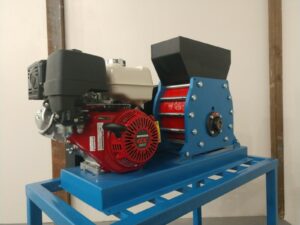 They work by feeding ore into an opening in a steel casing, the ore then impacts against a piece of square steel stock that spins at a fairly high rpm. The ore particles are repeatedly “hammered” until they are fine enough to exit the mill through very small openings, or slots. There are various materials used in different impact mills including lengths of chain, hinged hammers, and balanced steel, square stock.
They work by feeding ore into an opening in a steel casing, the ore then impacts against a piece of square steel stock that spins at a fairly high rpm. The ore particles are repeatedly “hammered” until they are fine enough to exit the mill through very small openings, or slots. There are various materials used in different impact mills including lengths of chain, hinged hammers, and balanced steel, square stock.
The main drawback to most impact mills is that they have a hard time reducing ore fine enough to release enough of the gold. It should be noted here that a lot of hard rock gold ores contain very fine gold particles.100 to 200 mesh gold sizes, sometimes much finer.
It may take several passes through the impact mill to reduce the ore size enough to free the gold. Even then you will be left with a percentage that will still not be fine enough. if your ore contains mostly 50 to 80 mesh gold, then an impact mill will work well.
Proper sample screening tests will tell you what size your ore needs to be to release at least most of the recoverable gold. Check the video below to see the basic functions of an impact mill.
Step 3. Fine Grinding
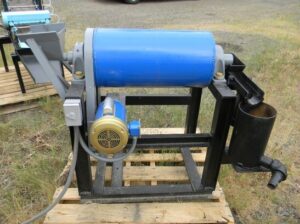 If most of the recoverable gold in your ore is released at 100 mesh or smaller you may want to use a ball mill for fine grinding. Small batch or flow through ball mills are very good at fine grinding.
If most of the recoverable gold in your ore is released at 100 mesh or smaller you may want to use a ball mill for fine grinding. Small batch or flow through ball mills are very good at fine grinding.
They work by feeding ore into a slowly spinning horizontal drum that is filled about half full of various sized steel balls. sometimes smooth and rounded river rock is used, hence the name pebble mill. In a flow-through unit, an overflow or screen discharge is used. when the ore reaches a fine enough grind, it flows out of the mill into a slurry tank, and then is fed across a concentrating table to recover the gold.
The problem with ball mills is that they can be very heavy and expensive. A small flow-through ball mill like the one above would do nicely in a small hard rock gold mill that processes finely divided gold from a high grade ore. An older, used ball mill, of about 2×4 foot will set you back from $4,000 to $5,000. If you need fine grinding to release your gold, you will probably be able to skip the impact mill and go directly from jaw to ball mill.
Step 4. Screening and Classifying
This is an important but often overlooked step in the milling process. This is why. Screening systems available are either too large and expensive for a small gold processing mill. Or are too small to process enough material.
A double deck vibrating screen will cost at least $10,000 or more, and even the smaller ones are designed for several tons an hour. A lab screening and sieving stacking shaker will create a bottleneck in your system as 10 or 20 pounds an hour would be all it could handle. They are designed only for small lab tests.
The only real solution would be to build a small vibrating wet deck, with at least two screen sizes. This would size your crushed ore properly for the next and final step.
Step 5. Concentrating Tables
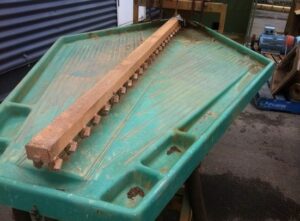 The most efficient way to separate your crushed ore from your gold is by using a concentrating, or shaker table. If the gold is coarse enough you might recover it by using a spiral wheel or a small clean-up sluice.
The most efficient way to separate your crushed ore from your gold is by using a concentrating, or shaker table. If the gold is coarse enough you might recover it by using a spiral wheel or a small clean-up sluice.
For my money though nothing can outperform a good quality shaker table. Properly tuned and set up a shaker table can recover gold down to about 600 mesh, much finer than any other method of concentration. They are most efficient when the ore has been sized by screening before being tabled.
The small-sized Gemini table GT60 shown above will process up to 65 pounds an hour. Good small production tables range from about $1,500 to $2,500. Gold Tables use a unique and precise motion to trap and move very fine particles of gold. The heavy fractions are moved or “bumped” along a series of parallel grooves and into catch trays, while the lighter, less dense material is washed over the table and into a tailings container. Check the video below to see one in action.
When you’ve finished tabling your ore, you will have a saleable gold concentrate. Sell to a refiner as-is, or refine, smelt and pour your own gold bars. I will post another article soon going over just how to do this. It’s not as hard as you might think.
By employing the above methods you can effectively process gold ore, up to about 500 pounds a day. If your ore averages about 4 ounces of recoverable gold per ton, that would be about an ounce of gold recovered per day. 4 ounce per ton is my cut off. I wont work an ore that averages less than that. Do your research. Get out and do some prospecting. Learn to properly sample different ores. You will find 4 ounce a ton ore. Chances are good that you will find small, workable amounts of ore that are quite a bit more than 4 ounces a ton. They are out there. Good luck!
